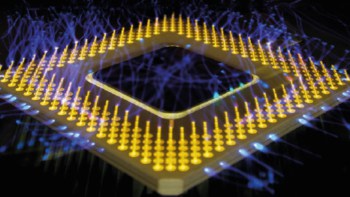The goal of all-polymer electronics has motivated an increasing number of research groups around the world for the past 20 years. These groups hope to provide plastics – which have the advantages of low-cost processing, flexibility and toughness – with the electronic properties needed for practical circuitry. In the past few months, exciting new results towards this goal have been reported by three independent groups from Cambridge University in the UK, Bell Laboratories in the US and Philips Research Laboratory in the Netherlands. The Cambridge and Bell Labs groups have both succeeded in integrating a polymeric transistor with an organic light-emitting diode (H Sirringhaus et al . 1998 Science 280 1741; A Dodabalapur et al . 1998 Appl. Phys. Lett . 73 142). Organic light-emitting diodes (LEDs) are under development in laboratories from Japan to California, and could be used for flat-panel displays in devices such as pagers and cellular phones, and perhaps eventually in televisions and computer screens. The active layer in an organic LED is a fluorescent organic material, either a specially designed polymer or a small dye molecule, that emits light when an electrical current passes through it. Most work to date combines this organic layer with other components – such as substrates, electrodes and the encapsulation material needed to protect the device – that must be made from inorganic compounds. The ultimate aim of the new work is to produce a fully functioning display, including the driving circuitry, made almost entirely from plastic materials. Both the Cambridge and Bell groups have constructed field effect transistors (FETs) with a semiconducting polymer as the active material in the channel. They used a derivative of polythiophene – regioregular poly-3-hexylthiophene – that exhibits one of the highest carrier mobilities and one of the best transistor on/off ratios of any polymer to date. This organic transistor makes it possible to turn the light from the organic diode on and off. The Cambridge group used an orange-emitting polymer – a derivative of polyphenylenevinylene – while the Bell team fabricated organic LEDs from small organic molecules deposited by thermal evaporation. Although these two reports clearly represent significant progress towards the goal of a cheap, flexible display, there are still many obstacles to overcome. The Bell Labs scheme used several conventional and inherently expensive photolithographic steps, one of which is critical to achieving the short channel length needed to get sufficient current through the transistor. For practical display applications, the individual circuit that comprises each pixel must be reproduced across the length and breadth of the screen. Brightness and resolution are then determined by the relative areas occupied by the light-emitting diode and the transistor drivers. As the Cambridge team points out, the situation is made more difficult because the light output of an organic LED is proportional to the current passing through it. This means that at least two transistors are required for each pixel, with one charging a capacitor to maintain the on state of the second. A further problem is that a fairly large electric current is needed to run an organic LED screen of any significant size – typically 10 mA cm-2. This current must be carried by leads running to the pixels from the edge of the display, and is beyond the capabilities of all known conducting polymers. Inorganic materials such as metals and the transparent conductor indium-tin oxide, will continue to be used until improved polymers are developed, which raises processing costs and reduces the device flexibility. Lastly, there is the issue of encapsulation. Because they are sensitive to water and oxygen, organic LEDs must be carefully protected from the environment. Plastic films can only provide protection for a few months, and so most groups developing organic LEDs for display applications are focusing on inorganic or composite encapsulation materials. In contrast, the Philips group has focused on electronic identification tags (Appl. Phys. Lett . 1998 73 108). This is a much less demanding application than displays, and one that may be much more amenable to early commercial development. Each tag is set to transmit a unique pattern of bits, an electromagnetic songbird if you will. The group has developed the electrical circuitry needed to produce a programmable generator of digital code, and in this case the fabrication is truly “all plastic”. The complex pattern of electrical connections is produced by exposing the conducting polymer – polyaniline doped with camphorsulphonic acid – to ultraviolet light. The insulating material, including the gate insulator of the transistor, is polyvinylphenol, and semiconducting polythienylenevinylene is used for the channel. Even the substrate is plastic. The intended application can tolerate quite low digital data rates and small currents, so the relatively poor conductivity of the polymers is not a problem. Volume production may reduce costs enough for the tags to be viable alternatives to conventional bar codes in shopping and inventory control. These new tags have the potential to store far more information than today’s passive tags, and they would not need the manual manipulation required by laser-scanned optical bar codes. The work highlighted in this article represents only a snapshot of the progress that is being made at these three labs in using polymeric materials for electronics. Much independent work is going on in various locations, and it is not yet clear what the first commercial applications will be. Perhaps soon, Benjamin will give his graduating granddaughter two words of advice: “plastic electronics”.
Electronics put it on plastic
01 Oct 1998
Campbell Scott is in the IBM Research Division, Almaden Research Center, San Jose, California, US


